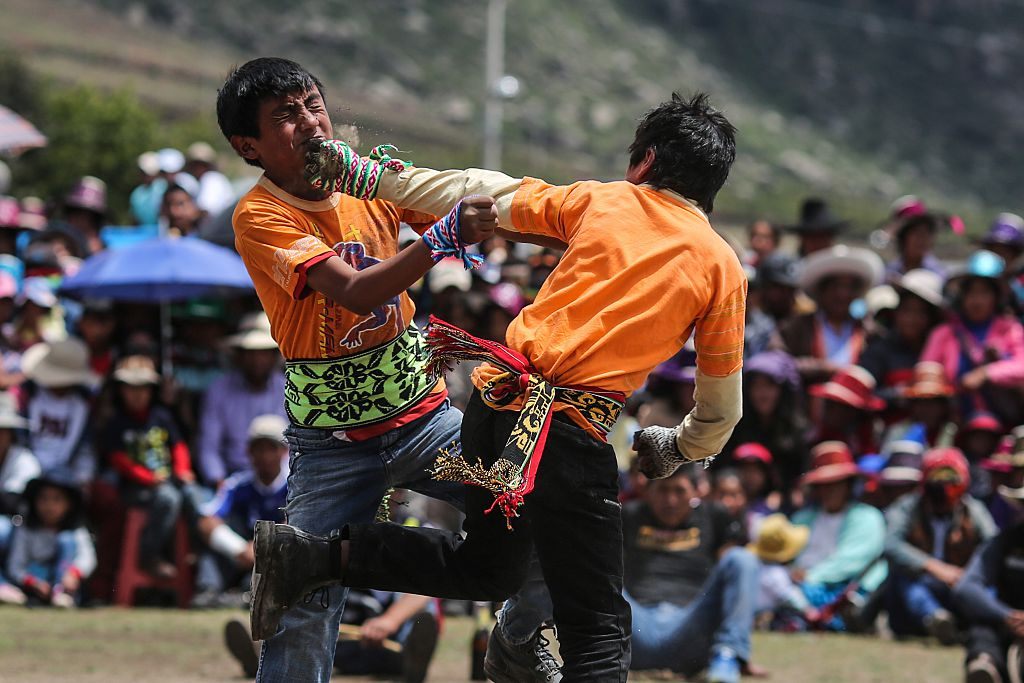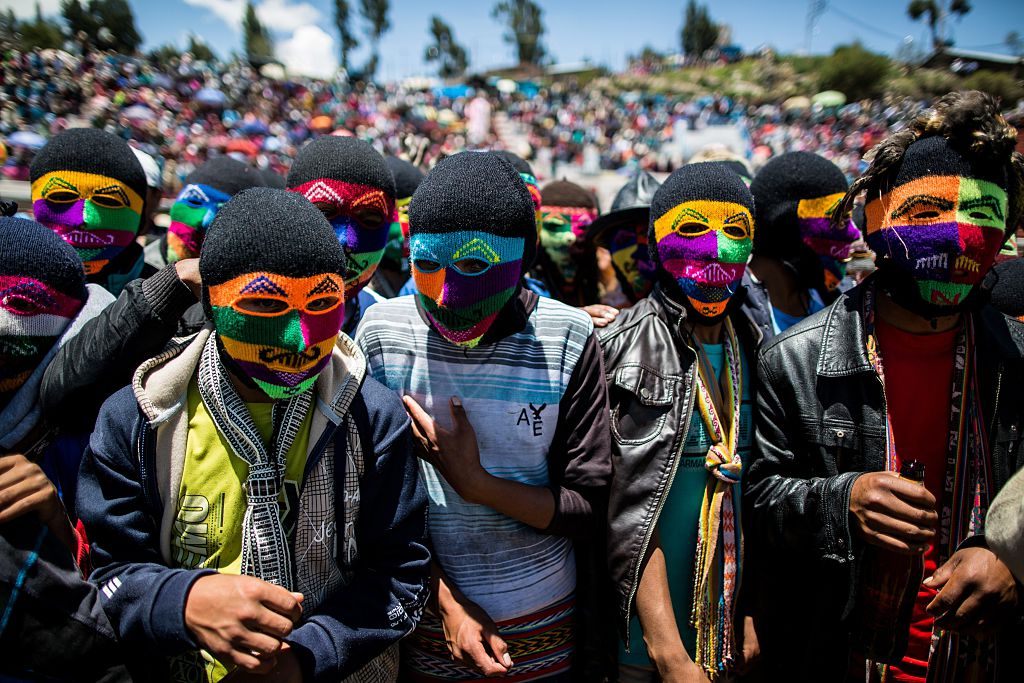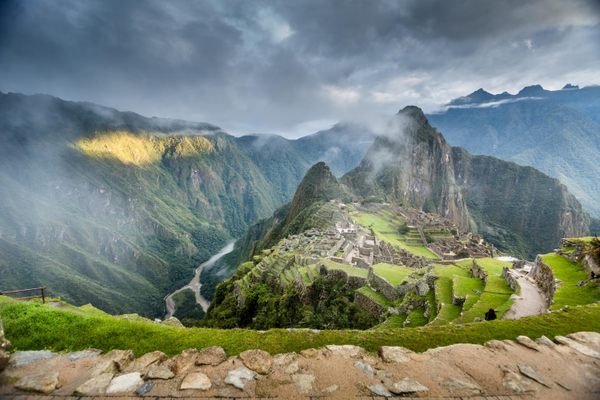December 25, Day of the Fistfighting Festival
In the Peruvian province of Chumbivilcas, physical conflict is an annual sporting event.

December 25 is commemorated as a day of peace for many cultures across the globe, but in the Peruvian province of Chumbivilcas, the day doubles as Takanakuy, a festive fistfight between neighbors. High in the Andes Mountains, friends, rivals, and relatives square off to settle year-long disputes in an annual airing of grievances.
The Quechua term “Takanakuy” means “to hit each other,” and while the tradition’s exact origins are up for debate, the modern observance is the perfect opportunity to blow off steam over legal matters, stolen lovers, or pure bravado.
In Santo Tomás, the capital of Chumbivilcas, men and women, young and old may participate, while rules and contestants vary in other towns. Beyond the fisticuffs, locals sing, dance, pray, and imbibe beer as well as a fermented corn beverage called chicha (the thicker the better).
In their report, “Peleas rituales: la waylía takanakuy en Santo Tomás,” anthropologists Máximo Cama and Alejandra Ttito Tica document their observations at Takanakuy events throughout the Andean highlands.
To establish why the community fights, Cama and Tica recount the explanation of a spectator: “For grudges, for problems that come up during the year, they fight. If there is a young man who is already physically grown, and he wants to show off his strength, he may fight with others. That is a ritual fight; when it ends, they drink alcohol and chicha, and they are friends. It’s also like sport.”

The isolated community has also come to rely on Takanakuy to settle legal matters in lieu of a judge and jury. The Peruvian government maintains a minimal police presence in Santo Tomás, and the mountain-bound village is hours away from any form of conventional court.
Not every fight is spurred by hard feelings, however. Friends often fight for recreation, and maintain delighted smiles even as they pummel each other.
In the days before the fights, dancers parade through the streets and women sing traditional songs called waylilla. The lyrics often celebrate the defiance and strength of the enduring Quechua people in response to colonial influence, and the music is intended to stoke the combatants’ vigor. Accompanied by stringed instruments, the singers also weave themes of peace and conflict: “Child, don’t be afraid when rivers of blood flow, or when a hail of stones comes down.”
“The waylilla is sung with point and counterpoint, like call and response,” says Odi Gonzales, Professor of Quechua language and culture at New York University. “They are often songs of bravery. There is much machismo involved, celebrating one’s strength and skill in courage and love.”
Participants wear traditional Peruvian ski masks called uyach’ullu, typically decorated in various colors signifying the divisions of the cosmos. The masks are meant to conceal everyone’s identities so that fights don’t break out during the festivities. Many women wear vibrant dresses with sturdy boots, while some opt for blue jeans.
As the song and dance begins, revelers dress in costumes depicting characters from Andean history. Among the most common are the Majenos, horse riders that live around the Majes River. The cowboy-like Majenos don riding gear like leather chaps and hats, and effect an air of rugged machismo.
The qarawatana, a variation of this costume, features black biker attire, petrified birds of prey, or an animal skull worn on the head. Younger fighters tend to favor this sinister-looking garb above some of the more traditional costumes, and the motorcycle imagery lends a modern connotation to the character. “Young people go to the bigger cities and come back after seeing what they think is tough there, things like gangs,” says Gonzales. “They bring that interest in danger back for Takanakuy.”

Dancers in particularly fancy dress may model their costumes after Spanish slave owners. Formal clothes, silky capes, and flashy jewelry evoke images of riotous Mardi Gras krewes, and their rooster struts recall the cockfights of the colonial era.
Others may adorn themselves with bone or other deathly symbols to masquerade as the locust, which devastated the region during the 1940s. Yellow coats may be worn to represent miners digging for gold in the Andes. Those that want to fight but can’t be bothered with a costume are known as q’ara gallo, dressed in plain clothes but still wearing the mandatory mask.
On the morning of the fight, the dancers gather in the plaza in front of the church to eat picarones, a Peruvian dessert similar to fried donuts. Church bells ring to commemorate the birth of Christ, and the entire square takes on a convivial air before the impending melee. By 11:30 a.m., the crowd proceeds to the local bullring, as fighting at the church is explicitly forbidden.
Spectators fill the stands and walls that encircle the ring, and participants stand on ground-level, waiting for their turn. A challenger emerges from the crowd and calls their opponent by name. If the beckoned party does not wish to fight, they effectively admit the superior strength of their challenger. “To not ‘come out in front’ is harshly frowned up in the Santo Tomás society,” write Cama and Tica. “It’s like cowardice, lacking courage and valor, and that attitude is highly criticized by the women.”
The opponents wrap their knuckles and fight hand-to-hand, barred from any weapons, biting, or hair-pulling. Rules are sparse, but fighters are not permitted to kick an opponent when they fall. Officiators known as ronderos stand nearby, brandishing whips to prevent the fights from dissolving into chaos.
The fight ends when a combatant is knocked out or an official intervenes. It is customary for the opponents to shake hands or embrace as the dust settles to show that their animosity has been put behind them. In some cases, though, the bitterness persists and the beaten fighter may leave the ring with their face hidden in their palms. Friends and family may then challenge the winner to defend the defeated party’s honor.
Individual bouts typically last a minute or less, but the event continues for much of the day. When the fighting has ended, the participants return to their homes to eat and drink to dull the pain.
The opportunity to release one’s aggressions at Takanakuy is believed to prevent conflict from breaking out during the year, and the single holiday of fighting isn’t representative of daily life in Chumbivilcas. Among the Quechua, says Gonzales, “sudden violence is not typical.”
The tradition that began in Santo Tomás has spread to other communities throughout the Andes, and public arenas across the region now fill with challengers of diverse backgrounds, all eager to participate in the ritual fray. In recent years, Takanakuy has arrived in Peru’s largest cities, Lima and Cuzco.
The origins of the centuries-old custom are clouded by time, and the version you hear depends on who you ask. “If we enter the debate of who has the explanation, we will find multiple perspectives and answers,” write Cama and Tica. On the day before Takanakuy, they spoke with members of the crowd to learn how the rituals may have begun. Explanations varied, with some spectators pointing to the Spanish colonists who forced their slaves to fight. One suggested that sparring had been a form of amusement between powerful indigenous estates.
Another individual refers to anecdotes his grandfather told him: “The Spaniards gave rise to this and other customs, like cockfights, certain music, and bullfights. Before that, there were fights between the landowners, the ‘llaqta taytas.’ From there, these customs arose.”
It’s entirely possible that Takanakuy grew from a combination of Quechua customs and Spanish influence, incorporating old songs and rituals into the festival of today. “I think that this tradition has developed more recently,” says Gonzales. “Part of it may have risen from much older rituals like warachiku and tinku. Those were a series of initiation rites by which a teenager would become an adult. There were several competitions involved, but nothing so violent.”
Regardless of why the first opponents fought, the singing, dancing, and even fighting are a means for the Quechua people to celebrate their own identity amid the societal changes that they have faced over centuries. “They are expressions of a sense of belonging to a specific culture, and it affirms their values,” write Cama and Tica. “It reaffirms and strengthens their cultural identities. At the same time, it allows them to distinguish themselves from others.”












Follow us on Twitter to get the latest on the world's hidden wonders.
Like us on Facebook to get the latest on the world's hidden wonders.
Follow us on Twitter Like us on Facebook